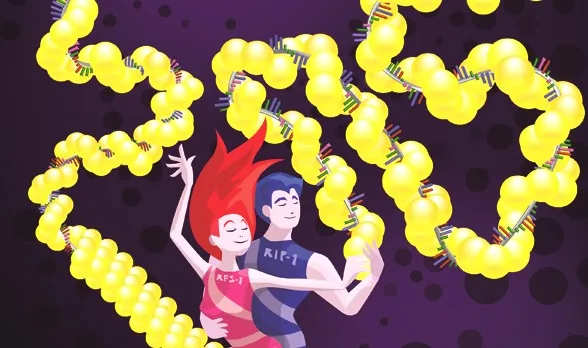Secrets of DNA Repair: The Essential Role of RAD51
In the intricate world of cellular processes, DNA repair stands out as a critical mechanism, ensuring the integrity and continuity of life. Among the legion of proteins that guard our genetic material, RAD51 emerges as a pivotal figure. This remarkable protein not only plays a vital role in homologous recombination, a key DNA repair pathway, but also reveals fascinating insights into cancer development and the innate immune response. Let’s delve into the multifaceted world of RAD51 and uncover its essential functions in DNA repair and beyond.

RAD51: The Architect of DNA Integrity
RAD51 is an ATPase, a type of enzyme that harnesses the energy from ATP molecules to fuel its activities. It is renowned for forming a nucleoprotein filament on single-stranded DNA, a process at the heart of its function. This filament acts as a scout, seeking out and invading homologous DNA sequences to facilitate accurate and timely DNA repair. Such precision is crucial in maintaining the genetic blueprint intact across generations.
A Key Player in Homologous Recombination
Homologous recombination (HR) is the cellular process that RAD51 is most closely associated with. HR is instrumental in repairing double-strand breaks (DSBs), one of the most severe forms of DNA damage. By guiding the repair machinery to precisely correct these breaks, RAD51 helps avert potential genetic catastrophes, preserving the cell’s genomic integrity.
Beyond DNA Break Repair: Stalled Replication Forks and More
RAD51’s role extends beyond mending DSBs. It is also a guardian of DNA replication, stepping in when replication forks—structures that replicate DNA—stall or become damaged. By regulating the formation of RAD51 filaments, it ensures that DNA replication can proceed smoothly, even in the face of damage, thus maintaining cellular health and function.
A Shield Against DNA Degradation
A particularly intriguing aspect of RAD51’s activity is its ability to block the MRE11-mediated degradation of nascent DNA strands in response to DNA damage. This protective role is vital for preventing the loss of newly replicated genetic information, showcasing RAD51’s importance in safeguarding DNA integrity during replication and repair.
The Cancer Connection: A Double-Edged Sword
RAD51 is expressed at high levels in many cancers, a fact that correlates with poor outcomes and reduced response to treatment. This highlights a complex relationship between RAD51 and cancer, suggesting that while RAD51 is essential for DNA repair, its dysregulation can contribute to cancer progression. Understanding this balance is crucial for developing targeted cancer therapies.
A Novel Role in Immune Response Signaling
Recent research has unveiled a previously unknown role for RAD51 in innate immune response signaling. Defects in RAD51 can lead to the accumulation of self-DNA in the cytoplasm, triggering a STING-mediated innate immune response. This groundbreaking discovery places RAD51 at the crossroads of DNA repair, replication, and immunity, highlighting its broader significance beyond just maintaining genetic fidelity.
RAD51: A Master Regulator at the Crossroads of Biology
RAD51’s multifunctional nature underscores its central role in DNA replication, homologous recombination repair, and now, the innate immune response. Its ability to maintain genomic stability, protect against cancer, and now, modulate immune signaling, positions RAD51 as a key player in the preservation of life at the molecular level. As we continue to explore the depths of cellular processes, RAD51 remains a beacon, illuminating the intricate connections between DNA repair, cancer, and immunity, and offering promising avenues for future research and therapeutic development.
References:
Sumpter R. Jr, Sirasanagandla S., Fernández Á.F., Wei Y., Dong X., Franco L., Zou Z., Marchal C., Lee M.Y., Clapp D.W. et al.. Fanconi anemia proteins function in mitophagy and immunity. Cell. 2016; 165:867–881. [PMC free article] [PubMed] [Google Scholar]
Wolf C., Rapp A., Berndt N., Staroske W., Schuster M., Dobrick-Mattheuer M., Kretschmer S., König N., Kurth T., Wieczorek D. et al.. RPA and Rad51 constitute a cell intrinsic mechanism to protect the cytosol from self DNA. Nat. Commun. 2016; 7:11752. [PMC free article] [PubMed] [Google Scholar]
Asaithamby A., Chen D.J.. Cellular responses to DNA double-strand breaks after low-dose gamma-irradiation. Nucleic Acids Res. 2009; 37:3912–3923. [PMC free article] [PubMed] [Google Scholar]
Zafar F., Seidler S.B., Kronenberg A., Schild D., Wiese C.. Homologous recombination contributes to the repair of DNA double-strand breaks induced by high-energy iron ions. Radiat. Res. 2010; 173:27–39. [PubMed] [Google Scholar]
Peng G., Chun-Jen Lin C., Mo W., Dai H., Park Y.Y., Kim S.M., Peng Y., Mo Q., Siwko S., Hu R. et al.. Genome-wide transcriptome profiling of homologous recombination DNA repair. Nat. Commun. 2014; 5:3361. [PMC free article] [PubMed] [Google Scholar]
